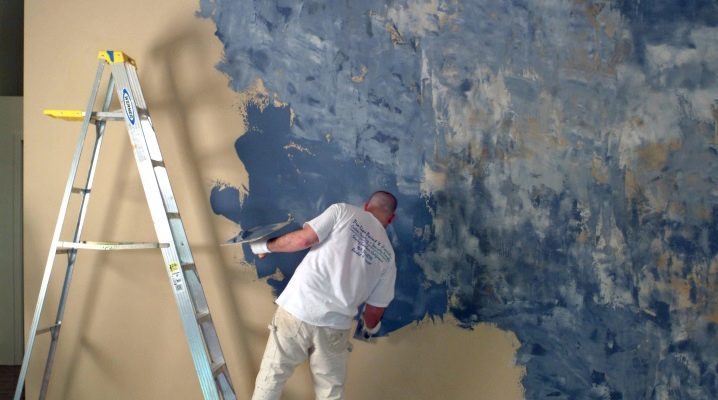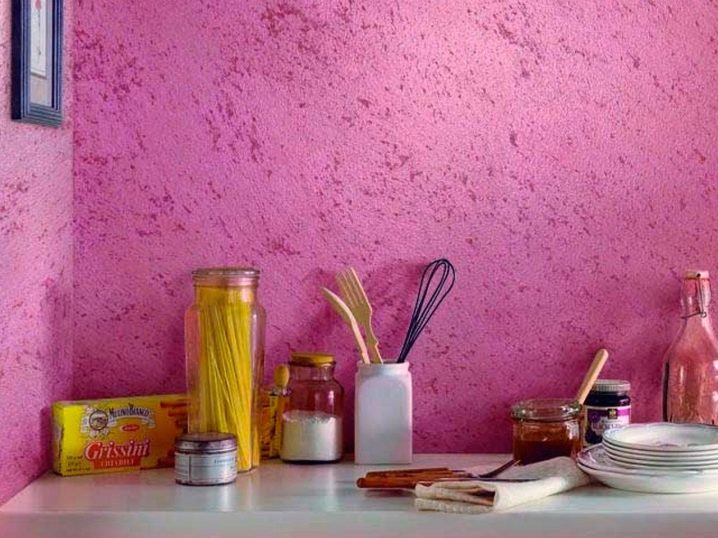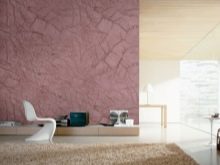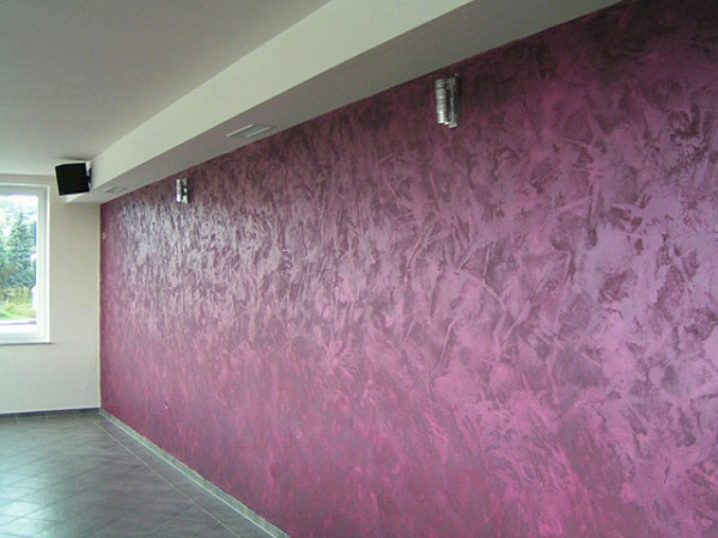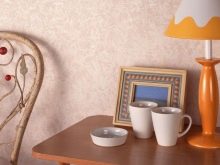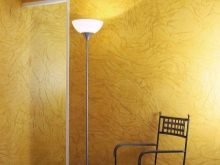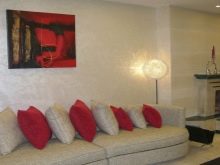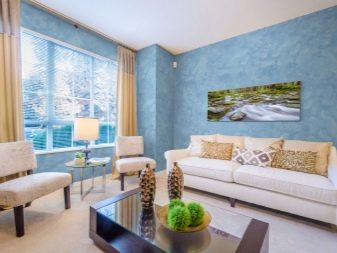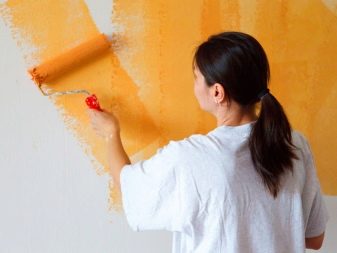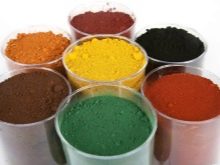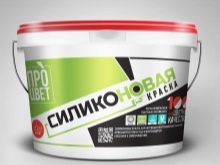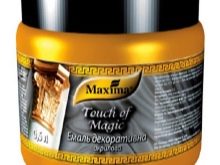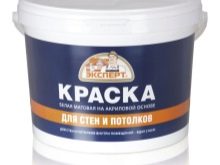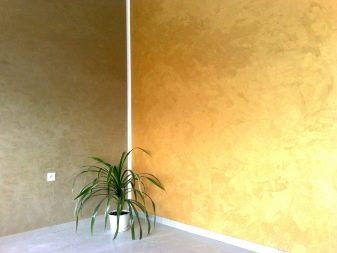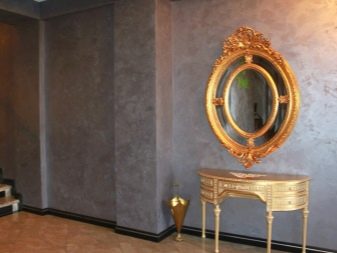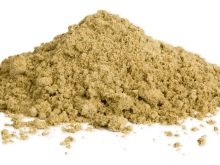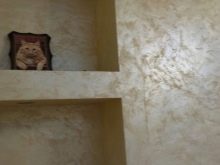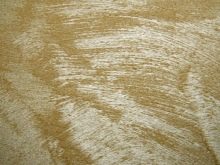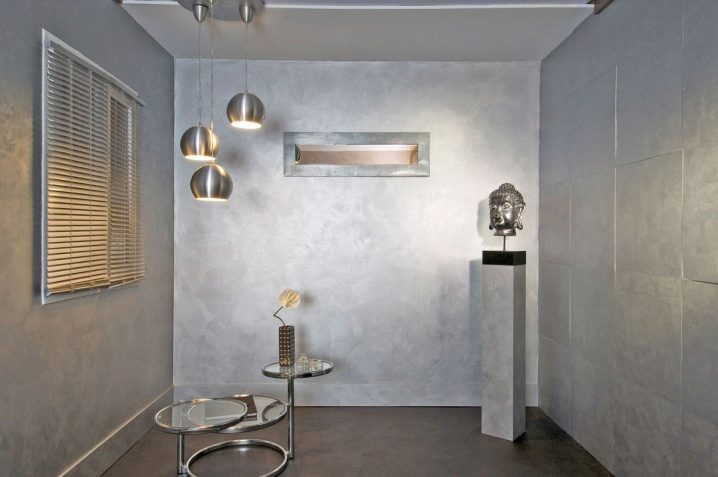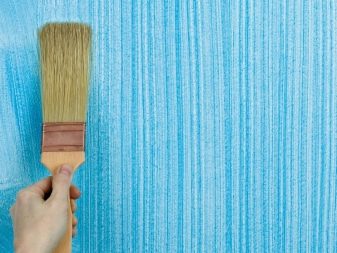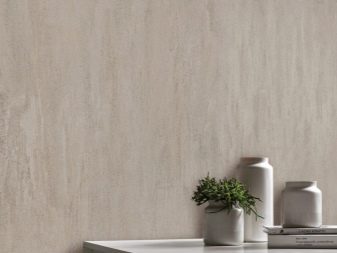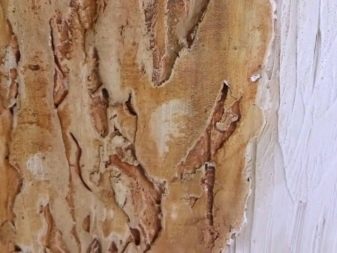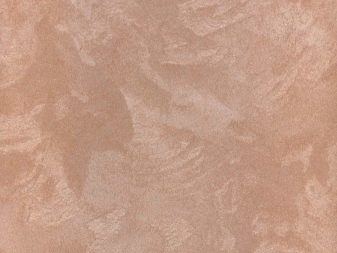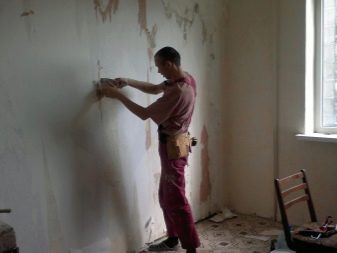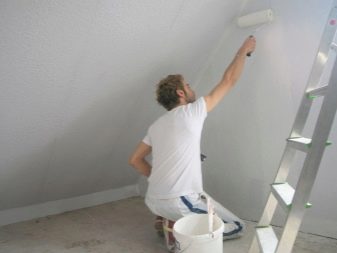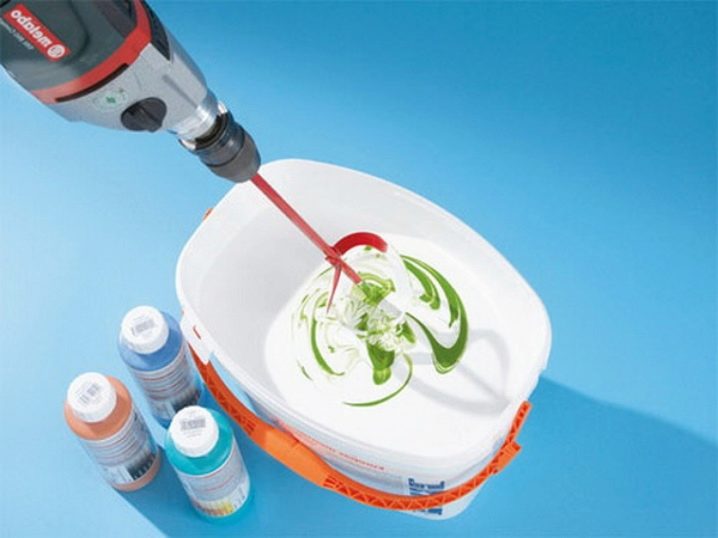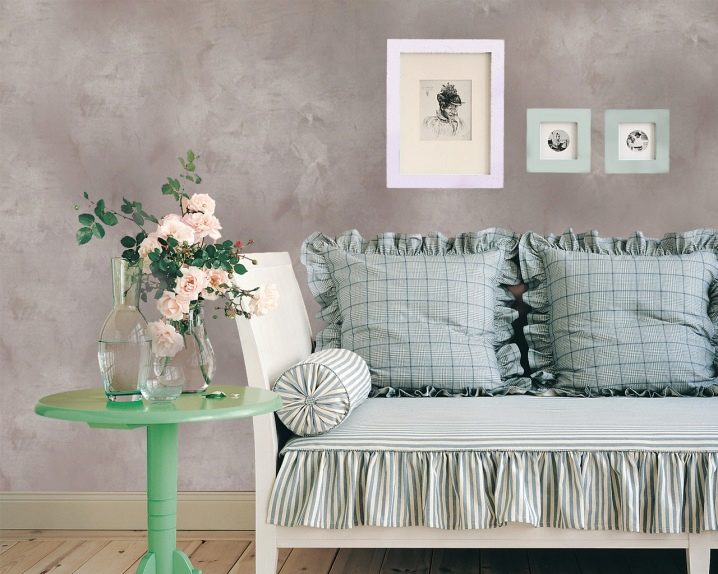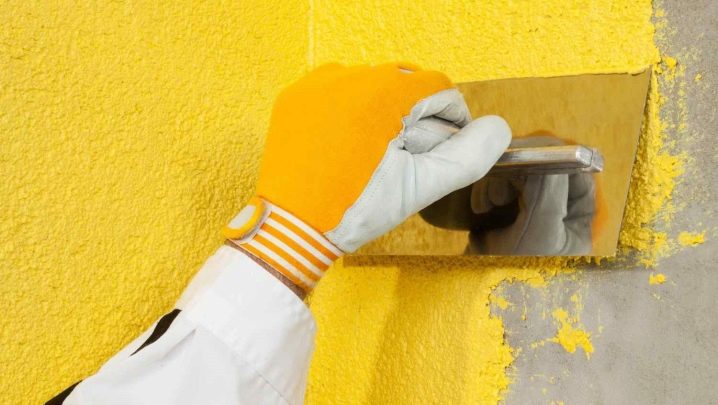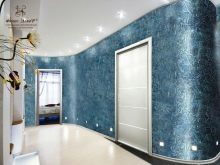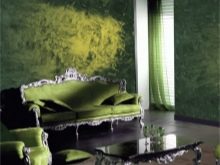Applying textured paint: do it yourself original ways
Textured (or textured) paint is a good material for wall finishing. This decorative composition is very popular and is often used when painting interior and exterior walls. Let's take a closer look at this finishing material and consider how it should be applied so that the coating is neat and beautiful.
Features, Pros and Cons
The main purpose of painting walls with textured color schemes is to give individuality to the design. In total, there are 2 main types of decorative paints: liquid and dry.
The difference of dry dye is that before starting work it must be diluted with water with added color. Liquid textured paint is initially ready for use.
The dense and thick texture of textured paint allows you to create beautiful, interesting patterns that complement the interior. In addition, they can be used to hide small imperfections of the walls (as opposed to wallpaper or ordinary paint). Due to its water resistance, structural dyes will be able to protect the room not only from moisture, but also from mold.
Let us consider in more detail the positive qualities of such materials:
- All options for this finish are absolutely safe and do not cause allergic reactions in humans, so they can be used in the nursery without worrying about the health of the child.
- Textured dyes have a long service life, in this they “outpaced” the wallpaper and simple paint. The average lifetime is 5-10 years.
- Resistance to moisture, sunlight (in contrast to wallpaper, decorative paint is not subject to fading) and frost.
- Permeability does not interfere with air circulation.
- Anti-aging is a characteristic feature of textured paints. The repulsion of dust and dirt is inherent in such materials, which allows you to keep the surface clean.
- Masking minor defects.
- A unique design that can be created according to your tastes and preferences.
There are few disadvantages of decorative paint, but they still have:
- Such compositions are quite expensive.Consumption is 1kg / sq m, and this is a big article in the family budget.
- They need training. The surface must be leveled.
- The paint will hide minor flaws, but deep cracks will need to be repaired by other means.
Kinds
Decorative paint, depending on the scope, effect, consistency and basis is divided into the following types:
- Mineral - dry in composition. More suitable for outdoor decoration. Consists of lime and cement.
- Silicone - known for its resistance to moisture, frost and other negative influences of the atmosphere.
- Silicate - it is used only in structure with a primer on the same basis. Compared to other options, not so cheap, but the most resistant to the influence of aggressive environment.
- Acrylic - A universal option that is immediately ready for use. To obtain the desired effect, you can add fillers.
There are also paints with unusual features. The silk effect coating looks very stylish. When light enters the composition begins to change color, which gives the effect of a chameleon.
Painting methods
The ease of use of textured dyes allows anyone without construction experience to create an interesting pattern on the walls in the apartment.
To create a specific design, you need to add a special filler, which depends only on your preferences. It can be quartz sand (fine particles), sawdust (large particles), light-reflecting elements (will add shine) or marble chips (gives sharpness to decoration). Depending on the selected item, a pattern will be formed. The larger the particles in the filler, the rougher and more noticeable the result.
If you choose small particles, for example, quartz sand, the result will be much smaller and sharper. Color also depends on the filler. For example, using light-reflecting particles it will turn out to achieve the effect of silk and nacre. It all depends on the breadth of your imagination.
All standard tools are suitable for painting process ^
- Putty knife. Apply the paint should be coarse strokes, a thin layer.
- Brush. Drawing is applied in different directions depending on the pile.
- Roller. The easiest way to apply a picture.
- Plain sponge. It creates the effect of a stone.
- Comb.Creates a clearer picture.
When you have decided on the consistency and instrument, you should come up with a design that you would like to see.
The most popular is the relief. Simple and fast painting method depends on the selected filler and method of application, as well as the chosen tool. For example, brushes with a short or long pile will apply the drawing in different ways. If the brush's nap is short, then the pattern will look like brush strokes, and with a long nap, thin lines will appear. If you use a sponge, a stone effect will be created.
With the roller work will go much easier. With this tool you can create a beautiful and smooth sketch. Passing along the walls, he leaves a straight, repetitive pattern. First you need to apply a textured white paint, then create a pattern using a roller, wait 1 day, then apply enamel. In the end you need to sand the result.
By adding a modified acrylic-based starch, the Mizuri effect can be achieved. With this option you get a smooth and textured pattern. After drying, cover the surface with shiny paint that will add to the walls of elegance due to protruding elements.
If you have professionalism in the field of construction, then you will definitely like Marseille wax. Refinement - this is the word that accurately describes this texture. It allows you to create the effect of old stone or imitation of the bark of a tree, the style of cork coating. Decorative wax is used at the end to give more color and saturation.
Reflective elements (such as quartz sand or metal particles) will give the surface an Atacam effect. When the base dries, it shines like velvet and fascinates.
Training
Before the main work it is necessary to create good ventilation. If finishing is carried out outside, the air temperature should be between +5 and +30 degrees. Do not work in hot or rainy weather.
- At the very beginning, as with any construction work, it is necessary to isolate the ceiling and floor from unwanted pollution. To do this, you can use the film and the usual scotch.
- Then you need to remove the old finishing material, rust, stains, as well as to repair the deep cracks. Tap with a hammer so that unnecessary fragments of plaster fall off.If mold is present, it must be treated with an antifungal primer.
- When all the defects of the surface are eliminated, we will cover the entire work area with an acrylic primer with the effect of “deep penetration”. It will add grip between the wall and the paint. It is better to apply it with an ordinary paint roller.
- You must wait at least 5 hours for the material to dry.
Useful recommendations
Before applying water-based paint, it must be thoroughly mixed, and then repeat these steps again after the filler has been selected and added. It is best to use a drill with a nozzle "mixer". It is necessary to stir from 5 to 10 minutes.
Paint should be applied in a thick layer. Coloring is best done immediately over the entire area to avoid the appearance of joints. Prepare a tool to work with in advance. One of the important factors is the choice of paint. Pay attention to the brand product. It is better to choose well-known and high-quality brands, such as "VGT", "Magic" and many others.
If the paint contains colored solid particles, the surface will have the effect of velor or velvet.When you add a filler, which includes elements such as quartz sand or shells, the pattern will look like a sandy surface (Atacama).
Matte options are good because the light is diffused when it hits the walls, thus hiding the imperfections of the surface. Adding to the paint special pigment fillers gives the composition a unique pearl shine.
Step-by-step application steps
When the color of paint, filler, tools and interior design are selected, you can begin the process of painting.
For this you need to prepare:
- Clothing should be with long sleeves (close the bare parts of the body). It is advisable to wear a hat so as not to stain your hair and, of course, gloves and glasses.
- It is better to apply decorative paint liquid on a consistence with a roller or a brush. First you need to mix the composition, dip the roller in it and apply the color scheme on the wall.
- It is necessary to carry out the work from the top down, otherwise you can not avoid stains. For applying the second layer, you can use other colors, as well as shaped roller, which will create an interesting pattern. However, it is necessary to follow the technique so that the drawing does not “float”.
- At the last stage, the layer is applied in the direction of the incident light rays to create a brighter effect.
- If you purchased a decorative paint of dry composition, then you will need a container for mixing at least 10 liters. The dye, filler and water are mixed in the composition indicated on the package. All components must be thoroughly mixed within 5-10 minutes.
- When the composition is ready, transfer a small amount to a container whose width is greater than the width of the trowel. It is better to apply paint with the short tool, and to level drawing wide.
- From tools suitable both flat and notched trowel. Remember, the greater the width of the teeth, the rougher the relief will be.
- To give the elements a finished look and brightness, an interior lacquer is applied on the entire surface of the base. The drying time is a day, and full drying will be achieved only after 2 weeks.
Remember that the resulting interior design depends only on your imagination. You can use stencils (patterns) to create interesting shapes or an original brush for the effect of star dust. It is also permissible to use bright (red, pink, maroon) colors to give a contrast to the room. An interesting effect will add and the use of hands.
For how to apply Ticiana textured paint, see the next video.
